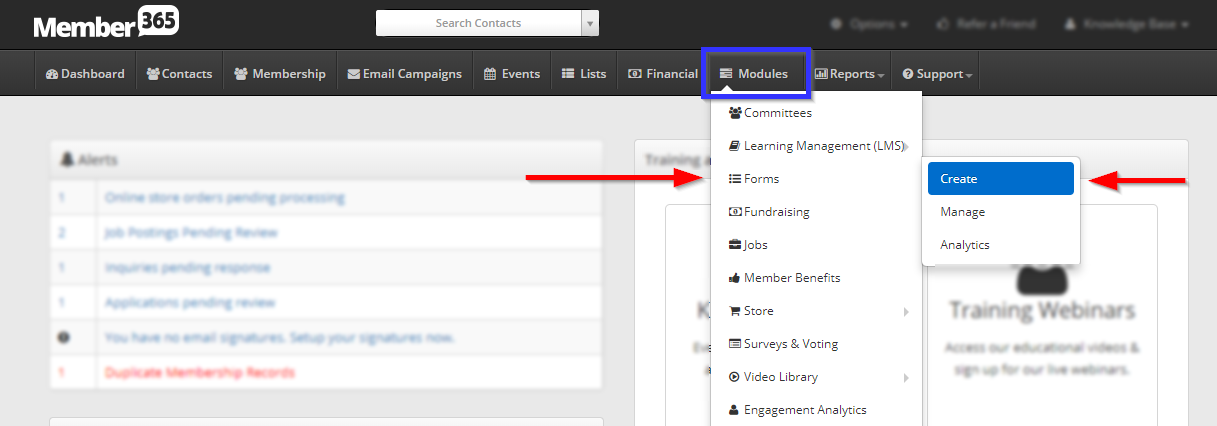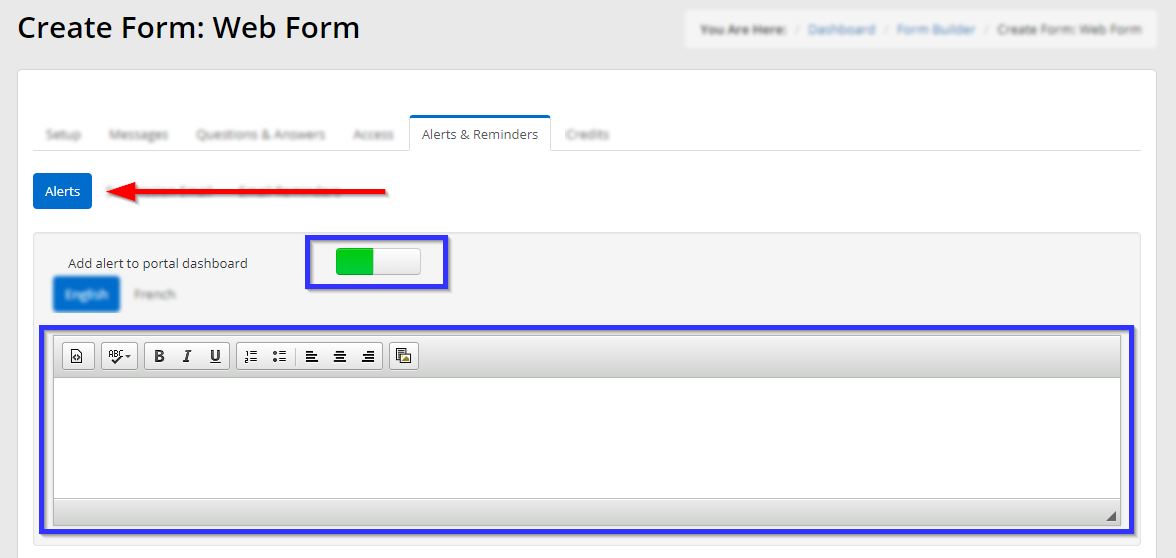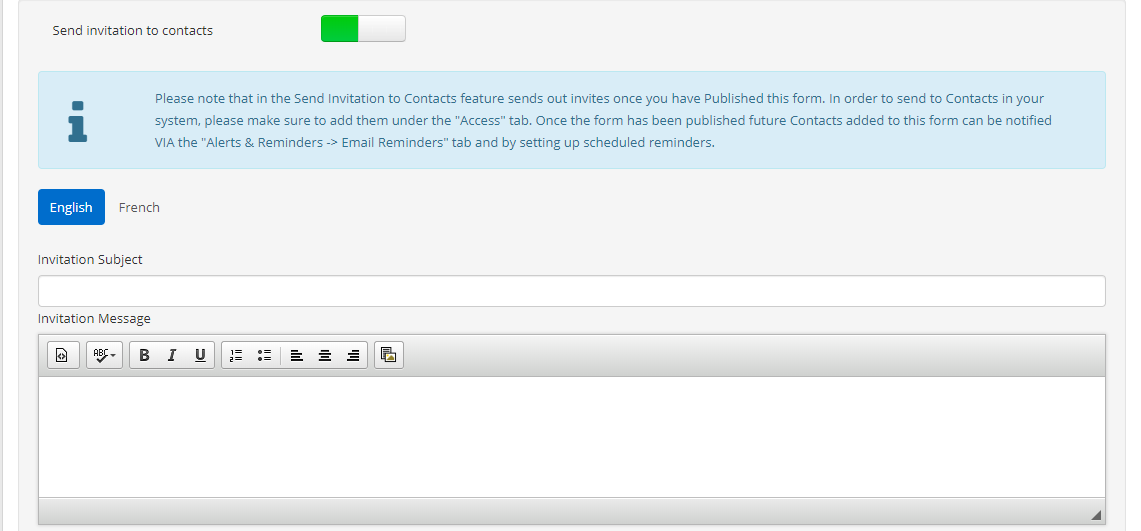This article will show you how to create a web submission form.
Admins can share a web submission form anywhere online by copying and pasting its HTML code. Web forms can also be accessed through a contact’s member portal, but you can limit access to certain types of members as an administrator.
Continue reading for tips on creating web submission forms and details on how to manage them.
Create a web form
1. From the Member365 admin panel, click on ‘Modules’ in the bar at the top of the page.
2. Hover over ‘Forms’ in the dropdown menu that appears, then click ‘Create’ in the next dropdown menu.

3. On the next page, click ‘Create‘ under the ‘Web Submission’ option.

Tab One: Settings
The Settings tab will allow you to specify properties for your web form as its name and layout.
Name and Category
Give your web form a name. Select your category from the dropdown menu or create a new category.

Category of your web form does not change its functionality and is simply to help you stay organized.
Configuring questions
Choose from the dropdown menu how you want your questions to be displayed to respondents.

All questions on one page– Entire form web is loaded as one continuous page when someone responds.
By Section/Table of Contents – Allow for more sophistication with how your web form loads. When creating your questions, you’ll have the option to create ‘Sections’, and these will serve as places your respondents can access!
Settings
The series of options in the Settings section allows you to further customize how your web form works.

Allow resubmission: Enable this option to allow contacts to submit the web form more than once. Turn this option off to allow only one submission per contact.
Lock Form: This option is a security measure to prevent you from accidentally deleting the web form. Leave it ON, unless you want to remove the form.
Show form questions and answers in member portal: Will you allow contacts to see analytics for this form? Continue reading here for more information.
Admin Email Notifications – If you enter an email address in this field, that email address will receive an email notification email every time someone responds to your website. From.
Open/Close Dates
Use the calendar icons to specify a date range for your web form.

No one will be able to access your web form before ‘Open on’ date, or after the ‘Close on’ date.
Tab Two: Messages
The next tab will allow you to customize the messages your respondents see when starting and ending your web form. The web form cannot be saved if any of these fields are blank.
Instructions
Use the text editor to customize the ‘Instructions’ message for your web form! The content you add here will be displayed to respondents before launching your form.

Send Message
Click on the following subtab to customize your ‘Send Message’. The content you add here will be displayed to respondents after they complete your form.
Tab Three: Q&A
You’ll create your web form content in this third tab! Follow the steps below to learn how to set up questions and answers.
The Form Question Editor
You can create your questions after clicking ‘Launch Question Editor from form button. We have a Knowledge Base article on the Form Question Editor if you need help using it.

Remember to ‘Save’ each individual question and ‘Save’ your the entire series of questions within the Form Question Editor to confirm the changes and return to the web form settings.
Tab Four: Access
The fourth tab lets you choose who can and can’t access your web form! See the series of options below to learn how to share your web form with as specific a subset of contacts as you need.

Members
This subtab displays a series of checkboxes, representing each category membership in your system. If you check a box, all active members of that category will be able to submit your web form.
Organization Categories
You can create and assign categories for organizations in Member365. You can choose to grant access to the web form to contacts who belong to organizations in a specific category.
Contact Demographics
Contact demographics allow you to categorize contacts in a manner independent of membership category. o Membership status. You can assign web form access to contacts in a specific demographic group.
Contacts
The Contacts subtab allows you to assign web form access to individual contacts on a case-by-case basis. base! Type their name or email address in the search field to allow them to submit the web form.
List Access
Use the dropdown menu if there is a specific contact list that you want to be able to submit your web form.
Public Link
Copy the HTML code from the Public Link subtab to embed your web form on your own website, and to share access to the form web with whoever you want.
Tab Five: Alerts & Reminders
Configure how your contacts will see the web form, through their member portals or by email.
Portal Alert
Turn on ‘Add Alert to Portal Dashboard’ to display a link to this web form on the Member Portal.
Only contacts who have been granted access from the ‘Access’ tab will see the alert and a link to the web form upon login.

Use the text below the switch to add your own custom message for the dashboard alert that will accompany the web form link.
Email Invitation
Turn on ‘Send invitation to contacts’ to set up an email containing a link to your web form.
When you click to publish your web form, all contacts you’ve assigned access to in the ‘Access’ will receive this invite email tion with a link to the web form.
 Email Reminders” tab and by setting up scheduled reminders.” />
Email Reminders” tab and by setting up scheduled reminders.” />
Email submission
Set up a submission email if you want respondents to receive an automatic email when they complete your web form.

Email Reminders
You can add email reminders that will be automatically sent to contacts who haven’t filled out the web form yet!In the ‘Email Reminders’ subtab, click ‘+ Add Reminder’.

Contacts who are assigned to the web form through the settings in your ‘Access’ tab will receive these email reminders automatically on the date you specify.

Tab Six: Credits
Use the ‘Credits’ Subtab if you want to turn this web form into an activity in your continuing education module.
Specify the number of credits and activity level based on necessary.

If your organization does not use continuing education, you can ignore this tab!
Congratulations, you now know how to create and configure a web form in Member365 !
.
